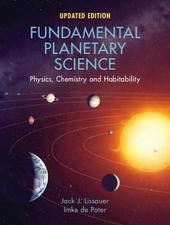
|
Fundamental Planetary Science: Physics, Chemistry and Habitability
Paperback / softback
Main Details
| Title |
Fundamental Planetary Science: Physics, Chemistry and Habitability
|
| Authors and Contributors |
By (author) Jack J. Lissauer
|
|
By (author) Imke de Pater
|
| Physical Properties |
| Format:Paperback / softback | | Pages:650 | | Dimensions(mm): Height 245,Width 188 |
|
| Category/Genre | Astronomy, space and time
Earth sciences |
|---|
| ISBN/Barcode |
9781108411981
|
| Classifications | Dewey:523.201 |
|---|
| Audience | |
|---|
| Edition |
Revised edition
|
| Illustrations |
Worked examples or Exercises; 32 Plates, color; 300 Halftones, black and white
|
|
Publishing Details |
| Publisher |
Cambridge University Press
|
| Imprint |
Cambridge University Press
|
| Publication Date |
4 July 2019 |
| Publication Country |
United Kingdom
|
Description
A quantitative introduction to the Solar System and planetary systems science for advanced undergraduate students, this engaging textbook explains the wide variety of physical, chemical and geological processes that govern the motions and properties of planets. The authors provide an overview of our current knowledge and discuss some of the unanswered questions at the forefront of research in planetary science and astrobiology today. This updated edition contains the latest data, new references and planetary images and an extensively rewritten chapter on current research on exoplanets. The text concludes with an introduction to the fundamental properties of living organisms and the relationship that life has to its host planet. With more than 200 exercises to help students learn how to apply the concepts covered, this textbook is ideal for a one-semester or two-quarter course for undergraduate students.
Author Biography
Jack J. Lissauer is a Space Scientist at NASA's Ames Research Center in Moffett Field, California, and a consulting professor at Stanford University, California. His primary research interests are the formation of planetary systems, detection of extrasolar planets, planetary dynamics and chaos, planetary ring systems, and circumstellar/protoplanetary disks. He is lead discoverer of the six-planet Kepler-11 system, co-discoverer of the first four planets found to orbit about faint M dwarf stars, and co-discoverer of two broad tenuous dust rings and two small inner moons orbiting the planet Uranus. Imke de Pater is a Professor in the Astronomy Department and the Department of Earth and Planetary Science at the University of California, Berkeley, and is affiliated with the Delft Institute of Earth Observation and Space Systems at the Technische Universiteit Delft, Netherlands. She began her career observing and modeling Jupiter's synchrotron radiation, followed by detailed investigations of the planet's thermal radio emission. In 1994, she led a worldwide campaign to observe the impact of comet D/Shoemaker-Levy 9 with Jupiter. Currently, she is exploiting adaptive optics techniques in the infrared range to obtain high angular resolution data of bodies in our Solar System.
|